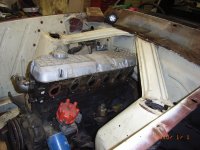Howdy Guys,
It's been a minute since I've been on but I'm in the planning and research stages for putting together the ultimate 200. I'm in the process of getting a modified aussie 2V intake thats been set up for MPFI. Already has injectors, fuel rail, and throttle body. I got my aussie head waiting to go to the machine shop as well as my low mount 200. I mentioned this before but I still plan to supercharge this too. So here's my ideal build, I need to know where to start for the MPFI/ignition system.
LM 200
1JZ forged H beam rods, custom forged pistons, ARP everything. Main girdle?
Aussie head, 1.75" intake, 1.5" exhaust, 1.65 yella terras, highly ported
Factory aussie 2v intake modified for MPFI
Coil on plug distributorless ignition, something like EDIS with LS coils
Paxton centrifugal supercharger (would like to end at around 14lbs or higher)
Not sure on cam for this yet
Focusing on the MPFI and ignition system, where should I start? I don't have a lot of experience with programming but I guess I'm gonna learn. Is the 300 EDIS system the one to use on the 200? How much more difficult is it to put on the coil on plug system? Does it require a different system? How do I make them all communicate with each other? There's a lot here.
I'd appreciate tips on how to approach this. I'm not sure if this helps, but I currently have the hyperspark system on the car, if reusing any of this is not possible then thats whatever.
Thanks!
It's been a minute since I've been on but I'm in the planning and research stages for putting together the ultimate 200. I'm in the process of getting a modified aussie 2V intake thats been set up for MPFI. Already has injectors, fuel rail, and throttle body. I got my aussie head waiting to go to the machine shop as well as my low mount 200. I mentioned this before but I still plan to supercharge this too. So here's my ideal build, I need to know where to start for the MPFI/ignition system.
LM 200
1JZ forged H beam rods, custom forged pistons, ARP everything. Main girdle?
Aussie head, 1.75" intake, 1.5" exhaust, 1.65 yella terras, highly ported
Factory aussie 2v intake modified for MPFI
Coil on plug distributorless ignition, something like EDIS with LS coils
Paxton centrifugal supercharger (would like to end at around 14lbs or higher)
Not sure on cam for this yet
Focusing on the MPFI and ignition system, where should I start? I don't have a lot of experience with programming but I guess I'm gonna learn. Is the 300 EDIS system the one to use on the 200? How much more difficult is it to put on the coil on plug system? Does it require a different system? How do I make them all communicate with each other? There's a lot here.
I'd appreciate tips on how to approach this. I'm not sure if this helps, but I currently have the hyperspark system on the car, if reusing any of this is not possible then thats whatever.
Thanks!
Last edited:



